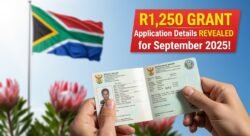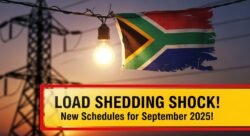Free Basic Electricity Program: I’m excited to share some potentially life-changing news with you today. The government has confirmed a new initiative set to launch in September 2025 that will provide free basic electricity to eligible households across the country. This program aims to alleviate the financial burden of rising energy costs for low-income families, seniors on fixed incomes, and other vulnerable populations. As utility bills continue to climb, this initiative could make a significant difference in many people’s monthly budgets. But who exactly qualifies, and how can you ensure you’ll benefit from this free basic electricity program?

What is the September 2025 Free Basic Electricity Program?
The September 2025 Free Basic Electricity Program is a government initiative designed to provide a baseline amount of electricity at no cost to qualifying households. The program recognizes electricity as an essential service and aims to ensure that all citizens have access to a minimum level of power regardless of their financial situation. Under this program, eligible households will receive a predetermined amount of kilowatt-hours each month at no charge, covering basic needs such as lighting, refrigeration, and essential electronic devices. This isn’t unlimited free electricity, but rather a carefully calculated baseline amount that covers fundamental household requirements. The free basic electricity allocation is intended to cover approximately 30-40% of an average household’s monthly electricity consumption, providing meaningful relief while still encouraging energy conservation.
Why the Government is Offering Free Basic Electricity
The decision to implement the free basic electricity program stems from several key factors. First, there’s growing recognition that energy poverty is a significant issue affecting millions of citizens who struggle to keep their lights on and homes at safe temperatures. Second, as climate initiatives push for cleaner energy, the government acknowledges that transition costs often disproportionately affect lower-income households. This program helps balance the scales during our national energy transition. Third, economic analyses have shown that reducing essential living costs for vulnerable populations has multiplier effects throughout the economy, as it frees up household income for other necessities and stimulates local spending. Finally, there’s the humanitarian aspect – in a modern society, access to basic electricity is increasingly viewed not as a luxury but as a fundamental right that supports health, education, and quality of life.
How to Qualify for Free Basic Electricity
Qualifying for the free basic electricity program depends on several criteria that have been established to ensure the benefit reaches those most in need. To be eligible, you’ll need to meet at least one of the following requirements:
- Household income below 150% of the federal poverty line
- Current enrollment in other government assistance programs such as SNAP, Medicaid, or SSI
- Senior citizens (65+) with limited income
- Families with children under 18 and demonstrated financial hardship
The application process will open six months before the program launch, in March 2025. You’ll be able to apply online through a dedicated government portal, by mail using forms available at post offices and community centers, or in person at designated government offices. Documentation requirements will include proof of identity, residence, income, and household composition. I recommend gathering these documents early to ensure a smooth application process. The government has promised a streamlined verification system that will cross-reference existing benefit databases to minimize paperwork for those already receiving other forms of assistance.
When and How Payments Will Be Distributed
Once you’ve qualified for the free basic electricity program, you won’t actually receive direct cash payments. Instead, the benefit will be applied directly to your electricity bill. Starting in September 2025, your monthly utility statement will show the free basic electricity allocation as a credit, reducing the amount you owe. For most households, this will appear as a line item labeled “Government Basic Electricity Benefit” followed by the kilowatt-hour allocation and corresponding monetary value. If your usage falls below the allocated free amount, you won’t receive the difference in cash, but some jurisdictions are considering allowing excess credits to roll over to subsequent months. The program is initially approved for a three-year period, with annual reviews to assess effectiveness and make necessary adjustments. Recipients will need to recertify their eligibility annually, though the process is expected to be significantly simpler than the initial application.
 Youth Grant September 2025 R12,500 – Full Guide Released for Application Process Across SA
Youth Grant September 2025 R12,500 – Full Guide Released for Application Process Across SA
Real-Life Impact: The Johnson Family
Consider the Johnson family – a household of four with a combined income just below the eligibility threshold. Currently, they spend approximately $180 monthly on electricity, often forcing difficult choices between adequate heating and other essentials during winter months. Under the free basic electricity program, they would receive roughly $70 worth of free electricity each month. This $840 annual savings would allow them to maintain comfortable home temperatures year-round, eliminate the need to choose between electricity and other necessities, and even build a small emergency fund. For families like the Johnsons, the free basic electricity program represents not just financial relief but also improved health outcomes and quality of life.
I hope this information helps you understand the upcoming free basic electricity program. If you think you might qualify, mark your calendar for March 2025 when applications open. This initiative could make a significant difference for millions of households struggling with energy costs. Have you been feeling the pinch of rising electricity bills? This program might be exactly what you need to ease that monthly burden.



